NDVI stands for "Normalized Difference Vegetation Index". NRG stands for "Near-infrared / Red / Green". NDVI and NRG are both ways to visualize the amounts of infrared and other wavelengths of light reflected from vegetation. Because both these methods compare ratios of blue and red light absorbed versus green and IR light reflected, they can be used to evaluate the health of vegetation. It's a snapshot of how much photosynthesis is happening. This is helpful in assessing vegetative health or stress. (Read more here: https://www.agronomy.org/publications/jeq/articles/36/3/832) ## Do-It-Yourself These techniques for vegetation analysis were developed for satellite imagery, but at Public Lab, we've been working a lot on capturing infrared imagery using our DIY [near-infrared camera](/wiki/near-infrared-camera) setup, and combining it with visible bands to produce NDVI images such as the one above. ## What these images mean What exactly are these images we're trying to make? What do they tell us about vegetation, and why? These diagrams should help to understand what it is we're doing and why these are good ways to analyze plant life. ## The NDVI equation [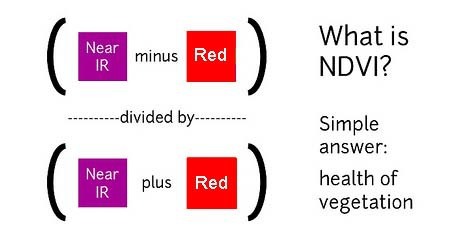](/i/44723) **NDVI = (Near Infrared - Red)/(Near Infrared + Red)** NDVI is a ratio which tries to emphasize photosynthesis while filtering out sun glare. The above equation is run for every pixel, using source data from an infrared photo and a visible light photo, like this pair: [](https://publiclab.org/system/images/photos/000/021/771/original/5390895115_c9d4d38fec_o.jpg) The result can be false-colored to make the high-photosynthesis areas more clear, and used to examine where plants are and how healthy they are. [](https://publiclab.org/system/images/photos/000/021/770/original/PetVISNDVIcomp.png) _Figure above: Normal color photo (right) and normalized difference vegetation index (NDVI) image (left). NDVI image was derived from two color channels in a single photo taken with a camera modified with a special infrared filter. Note that tree trunks, brown grass, and rocks have very low NDVI values because they are not photosynthetic. Healthy plants typically have NDVI values between 0.1 and 0.9. -- @cfastie_ ### Activities Here are a range of activities you can do to produce and interpret your own NDVI imagery, whether downloaded from a satellite imagery provider or [collected yourself using a DIY technique](/wiki/multispectral-imaging) [activities:ndvi] ****   Most DIY converted cameras today (those from Public Lab) use RGN instead of NRG, so the blue channel represents infrared instead of the red channel. That looks like this: [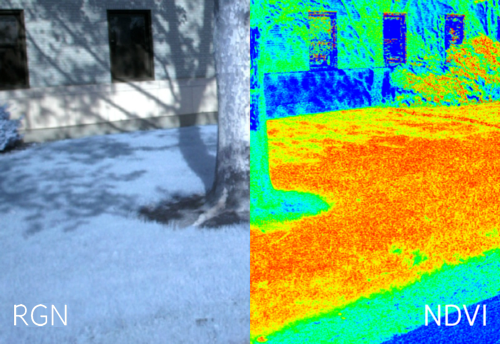](/i/45468?s=o) **** ## NRG imagery Some people are also interested in producing NRG imagery (like the below image), where `Near-Infrared, Red, and Green` are used to compose a picture instead of the usual `Red, Green, and Blue`. [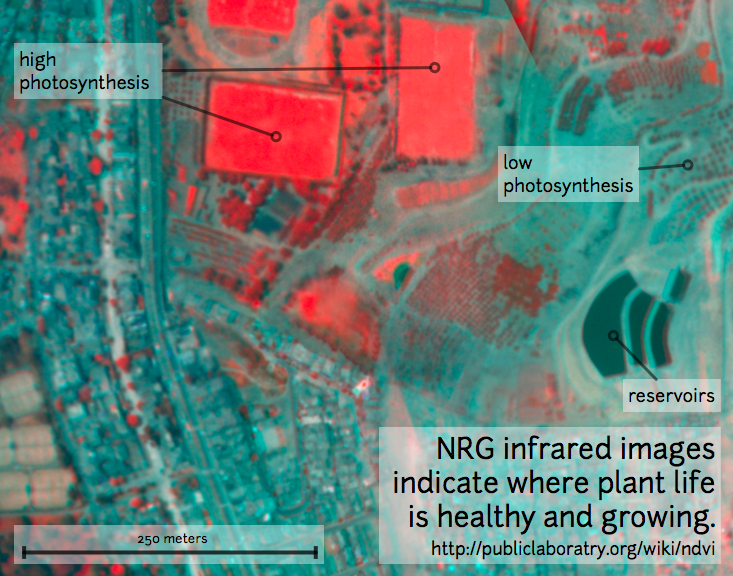](/i/25064) This diagram explains the swapping, which allows us to 'see' infrared as if it were a normal color: [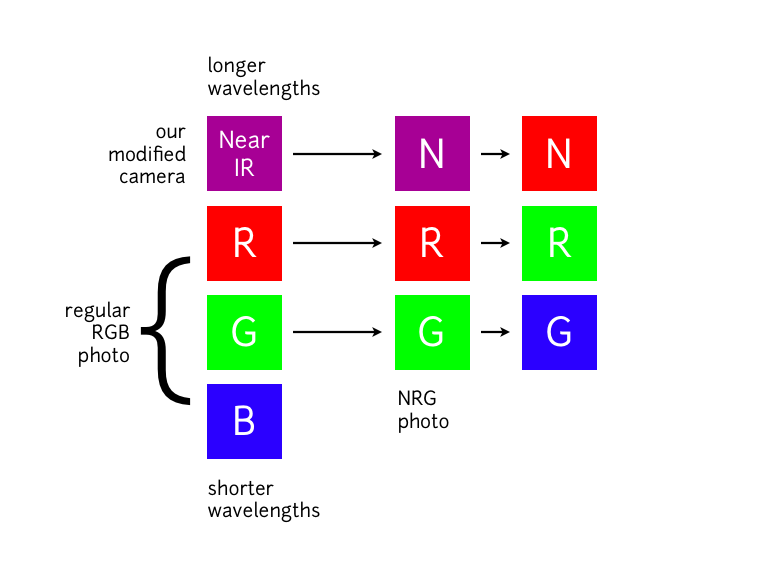](/i/25063) **In NRG images, the deeper and clearer the red color, the denser and healthier the vegetation (more or less).** ### Questions [questions:ndvi] ### Other examples of DIY NDVI imaging From around the internet: Begin watching at 2 minutes to see the resulting imagery: *This topic is part of the [Grassroots Mapping Curriculum](/wiki/mapping-curriculum) series.* **** [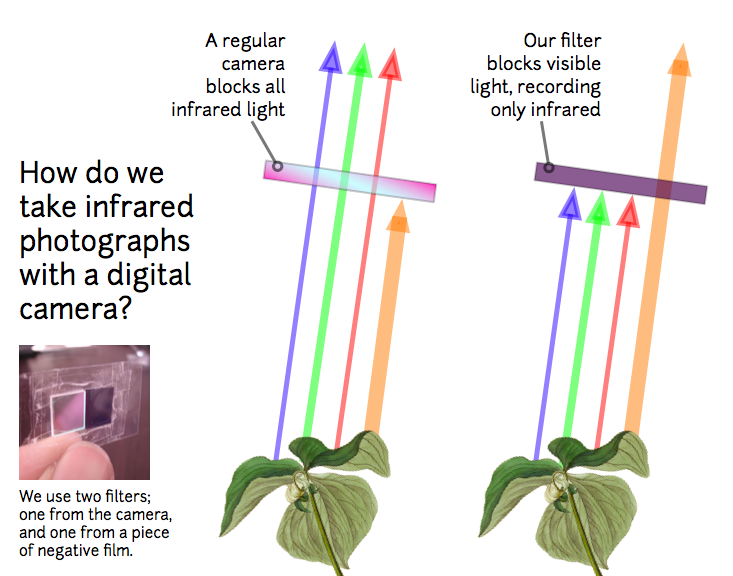](/i/25066) [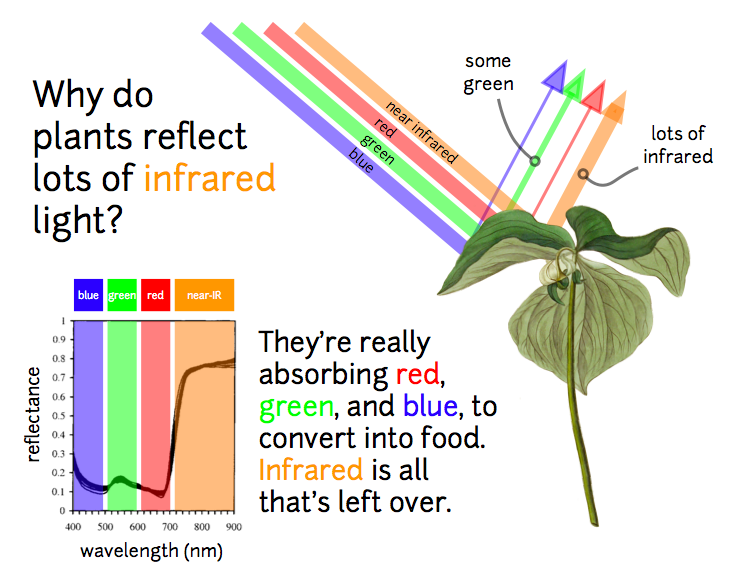](/i/25065) ...
| Author | Comment | Last activity | Moderation | ||
|---|---|---|---|---|---|
| aguchosolano | "Thanks! " | Read more » | about 10 years ago | |||
| aguchosolano | "Interesting results..I wonder why around one of the cars it is also green " | Read more » | about 10 years ago | |||
| patcoyle | "Tried it, see Flikr images of results at: https://flic.kr/s/aHsk6uLNsu " | Read more » | about 10 years ago | |||
| patcoyle | "Haven't tried it, but this site discusses how to Correct Fisheye in GIMP http://classroom.synonym.com/correct-fisheye-gimp-19646.html " | Read more » | about 10 years ago | |||
| eustatic | "This looks really good, how do i translate the PTLens stuff into GIMP or BIMP, like the folks in Maine are posting about? " | Read more » | about 10 years ago | |||
| patcoyle | "Thanks Stewart, I appreciated your suggestions on correcting the distortions. " | Read more » | about 10 years ago | |||
| gonzoearth | "The lens distortion correction and NDVI look great! " | Read more » | about 10 years ago | |||
| natalie | "Yes that's correct. We have about 100 of the Infrablu filters left. After those are gone, all the new Infragrams have one each of #74, and #19. " | Read more » | about 10 years ago | |||
| warren | "Hi, aguchosolano - the Public Lab store ships internationally and will send Rosco #74 or #2007. I believe they're going to start shipping #19 as we..." | Read more » | about 10 years ago | |||
| aguchosolano | "Thanks cfastie! I am from Argentina, so I will try to contact providers that could send the filters to my country. " | Read more » | about 10 years ago | |||
| cfastie | "Theatrical gels are a good substitute for more precise filters. Rosco #19 "Fire" behaves much like Wratten 25A and costs $7.00 for a huge (20x24") ..." | Read more » | about 10 years ago | |||
| aguchosolano | "Hello! Is there any "easy to find" material that I could use to take some pictures and calculate the NDVI? I mean, before buying expensive filters ..." | Read more » | about 10 years ago | |||
| cfastie | "Ned - The white balance preset used for those photos was "Sunny." Jeff Taylor at Event38 recommends either Cloudy or AWB, so it is apparently not t..." | Read more » | about 10 years ago | |||
| geraldmc | "More from Droneyard on the Schott BG3 compared to the Event38 custom filter plus a single image processing tutorial for Fiji. " | Read more » | about 10 years ago | |||
| nedhorning | "Interesting - My guess is that the preset white balance is responsible for the nice looking images. It would be interesting to record some RAW imag..." | Read more » | about 10 years ago | |||
| cfastie | "@camilochiang, Yes, you are correct that with a blue Rosco filter, the photo captured by the converted camera is (more or less) NGB. I think the di..." | Read more » | about 10 years ago | |||
| gpenzo | "Hi tagorecaue. I did not try different lenses any more. I checked my camera result with a farmer who uses a ndvi camera of a university and my res..." | Read more » | about 10 years ago | |||
| camilochiang | "Hi cfastie! I really think that your work is pretty awesome and for that im trying to do some experiments with the NoIR camara and your "Rosco filt..." | Read more » | about 10 years ago | |||
| tagorecaue | "Hi gpenzo, I read all your articles and would like to know if you have completed your work. Do you had better results with the filter 850 or 720? W..." | Read more » | about 10 years ago | |||
| PatrickC | "I still cant get the .lux file to work, and i need to get this working for class. is there a explanation to use the .gpl type files? TY, -Patrick " | Read more » | about 10 years ago | |||
| PatrickC | "you can find my posts here: http://publiclab.org/notes/PatrickC/11-13-2014/binocular-mobius-tripod-for-nvdi any help is appreaciated. " | Read more » | about 10 years ago | |||
| PatrickC | "Thank you for a quick response jtuhtan. I have the NDVI_VGYRM.lut, but have know idea how to use a .gpl file. Ive seen this: https://www.youtube.c..." | Read more » | about 10 years ago | |||
| jtuhtan | "Hi Patrick, To do this in GIMP you will need to work with indexed images and upload a GIMP palette file (.gpl) which follows the Fastie colormap. ..." | Read more » | about 10 years ago | |||
| jtuhtan | "Hi Patrick, To do this in GIMP you will need to work with indexed images and upload a GIMP palette file (.gpl) which follows the Fastie colormap. ..." | Read more » | about 10 years ago |